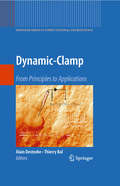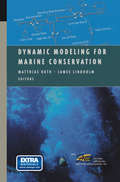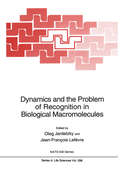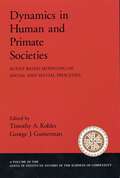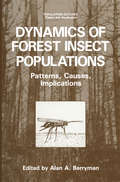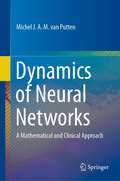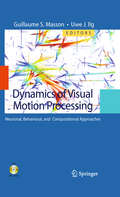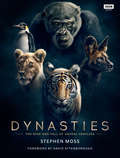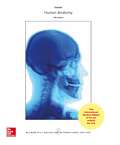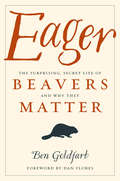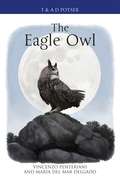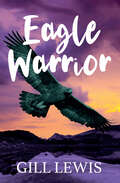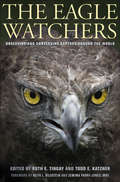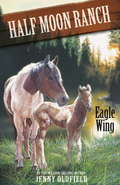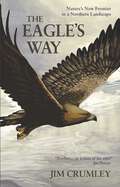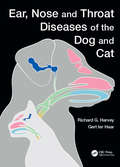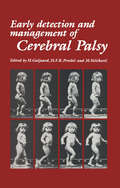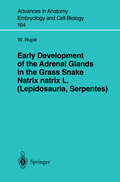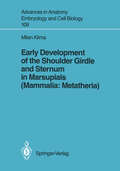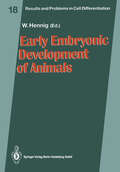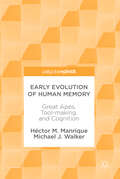- Table View
- List View
Dynamic-Clamp: From Principles to Applications (Springer Series in Computational Neuroscience #1)
by Thierry Bal Alain DestexheDynamic-clamp is a fascinating electrophysiology technique that consists of merging living neurons with computational models. The dynamic-clamp (also called “conductance injection”) allows experimentalists and theoreticians to challenge neurons (or any other type of cell) with complex conductance stimuli generated by a computer. The technique can be implemented from neural simulation environments and a variety of custom-made or commercial systems. The real-time interaction between the computer and cell also enables the design of recording paradigms with unprecedented accuracy via a computational model of the electrode. Dynamic-Clamp: From Principles to Applications contains contributions from leading researchers in the field, who investigate these paradigms at the cellular or network level, in vivo and in vitro, and in different brain regions and cardiac cells. Topics discussed include the addition of artificially-generated synaptic activity to neurons; adding, amplifying or neutralizing voltage-dependent conductances; creating hybrid networks with real and artificial cells; attaching simulated dendritic tree structures to the living cell; and connecting different neurons. This book will be of interest to experimental biophysicists, neurophysiologists, and cardiac physiologists, as well as theoreticians, engineers, and computational neuroscientists. Graduate and undergraduate students will also find up-to-date coverage of physiological problems and how they are investigated.
Dynamic Modeling for Marine Conservation (Modeling Dynamic Systems)
by Matthias Ruth E. A. Norse James LindholmThe effects of disturbed ecosystems, from devastating algal blooms to the loss of whale populations, have demonstrated the vulnerability of the oceans'biodiversity. This book provides methods for learning how ocean systems function, how natural and human actions put them in peril, and how we can influence the marine world in order to maintain biodiversity. The difficulties of research in the oceans make computer modeling particularly helpful for marine conservation. The authors demonstrate dynamic modeling through the use of the STELLA modeling program and case studies from marine conservation.
Dynamics and the Problem of Recognition in Biological Macromolecules (Nato Science Series A: #288)
by Jean-FrançoisLefèvre OlegJardetzkyFrom within complex structures of organisms and cells down to the molecular level, biological processes all involve movement. Muscular fibers slide on each other to activate the muscle, as polymerases do along nucleic acids for replicating and transcribing the genetic material. Cells move and organize themselves into organs by recognizing each other through macromolecular surface-specific interactions. These recognition processes involve the mu tual adaptation of structures that rely on their flexibility. All sorts of conformational changes occur in proteins involved in through-membrane signal transmission, showing another aspect of the flexibility of these macromolecules. The movement and flexibility are inscribed in the polymeric nature of essential biological macromolecules such as proteins and nucleic acids. For instance, the well-defined structures formed by the long protein chain are held together by weak noncovalent interac tions that design a complex potential well in which the protein floats, permanently fluctuating between several micro- or macroconformations in a wide range of frequencies and ampli tudes. The inherent mobility of biomolecular edifices may be crucial to the adaptation of their structures to particular functions. Progress in methods for investigating macromolecular structures and dynamics make this hypothesis not only attractive but more and more testable.
Dynamics in Human and Primate Societies: Agent-Based Modeling of Social and Spatial Processes (Santa Fe Institute Studies on the Sciences of Complexity)
by Timothy A. Kohler George G. GumermanAs part of the SFI series, this book presents the most up-to-date research in the study of human and primate societies, presenting recent advances in software and algorithms for modeling societies. It also addresses case studies that have applied agent-based modeling approaches in archaeology, cultural anthropology, primatology, and sociology. Many things set this book apart from any other on modeling in the social sciences, including the emphasis on small-scale societies and the attempts to maximize realism in the modeling efforts applied to social problems and questions. It is an ideal book for professionals in archaeology or cultural anthropology as well as a valuable tool for those studying primatology or computer science.
Dynamics of Forest Insect Populations: Patterns, Causes, Implications (Population Ecology)
by Alan A. BerrymanInsects multiply. Destruction reigns. There is dismay, followed by outcry, and demands to Authority. Authority remembers its experts or appoints some: they ought to know. The experts advise a Cure. The Cure can be almost anything: holy water from Mecca, a Government Commis sion, a culture of bacteria, poison, prayers denunciatory or tactful, a new god, a trap, a Pied Piper. The Cures have only one thing in common: with a little patience they always work. They have never been known entirely to fail. Likewise they have never been known to prevent the next outbreak. For the cycle of abundance and scarcity has a rhythm of its own, and the Cures are applied just when the plague of insects is going to abate through its own loss of momentum. -Abridged, with insects in place of voles, from C. Elton, 1924, Voles, Mice and Lemmings, with permission of Oxford University Press This book is an enquiry into the "natural rhythms" of insect abundance in forested ecosystems and into the forces that give rise to these rhythms. Forests form unique environ ments for such studies because one can find them growing under relatively natural (pri meval) conditions as well as under the domination of human actions. Also, the slow growth and turnover rates of forested ecosystems enable us to investigate insect popula tion dynamics in a plant environment that remains relatively constant or changes only slowly, this in contrast to agricultural systems, where change is often drastic and frequent.
Dynamics of Neural Networks: A Mathematical and Clinical Approach
by Michel J.A.M. van PuttenThis book treats essentials from neurophysiology (Hodgkin–Huxley equations, synaptic transmission, prototype networks of neurons) and related mathematical concepts (dimensionality reductions, equilibria, bifurcations, limit cycles and phase plane analysis). This is subsequently applied in a clinical context, focusing on EEG generation, ischaemia, epilepsy and neurostimulation. The book is based on a graduate course taught by clinicians and mathematicians at the Institute of Technical Medicine at the University of Twente. Throughout the text, the author presents examples of neurological disorders in relation to applied mathematics to assist in disclosing various fundamental properties of the clinical reality at hand. Exercises are provided at the end of each chapter; answers are included. Basic knowledge of calculus, linear algebra, differential equations and familiarity with MATLAB or Python is assumed. Also, students should have some understanding of essentials of (clinical) neurophysiology, although most concepts are summarized in the first chapters. The audience includes advanced undergraduate or graduate students in Biomedical Engineering, Technical Medicine and Biology. Applied mathematicians may find pleasure in learning about the neurophysiology and clinic essentials applications. In addition, clinicians with an interest in dynamics of neural networks may find this book useful, too.
The Dynamics of Thought (Synthese Library #300)
by Peter GardenforsThis book is a selection from the articles that I have written over a period of more than twenty years. Since the focus of my research interests has shifted several times during this period, it would be difficult to identify a common theme for all the papers in the volume. Following the Swedish tradition, I therefore present this as a smörgåsbord of philosophical and cognitive issues that I have worked on. To create some order, I have organized the sixteen papers into five general sections: (1) Decision theory; (2) belief revision and nonmonotonic logic; (3) induction; (4) semantics and pragmatics; and (5) cognition and evolution. Having said this, I still think that there is a common theme to my work over the years: The dynamics of thought. My academic interests have all the time dealt with aspects of how different kinds of knowledge should be represented, and, in particular, how changes in knowledge will affect thinking. Hence the title of the book.
Dynamics of Visual Motion Processing: Neuronal, Behavioral, and Computational Approaches
by Uwe J. Ilg Guillaume S. MassonMotion processing is an essential piece of the complex brain machinery that allows us to reconstruct the 3D layout of objects in the environment, to break camouflage, to perform scene segmentation, to estimate the ego movement, and to control our action. Although motion perception and its neural basis have been a topic of intensive research and modeling the last two decades, recent experimental evidences have stressed the dynamical aspects of motion integration and segmentation. This book presents the most recent approaches that have changed our view of biological motion processing. These new experimental evidences call for new models emphasizing the collective dynamics of large population of neurons rather than the properties of separate individual filters. Chapters will stress how the dynamics of motion processing can be used as a general approach to understand the brain dynamics itself.
Dynasties: The Rise and Fall of Animal Families
by Stephen Moss David AttenboroughFamily isn't just important. It's everything. From lions hunting as a pride to penguins huddling together to keep from freezing in the bitter Antarctic winter, many animals are dependent on complex social relationships for their survival. Powerful dynasties lay claim to vast swathes of territory, fighting off rivals and securing their hunting grounds for generations to come. Dynasties offers an immersive insight into the shifting hierarchies of animal families. Each chapter follows a different dynasty, from the Marsh Lions of the Masai Mara to rival packs of painted wolves, from a tiger protecting her newborn cubs to a chimpanzee troop and the penguin colonies of the Antarctic. Alongside tender moments when bonds are strengthened through grooming and play, the book charts the rivalries that tip the balance of power, when family members turn against each other and younger animals grow strong enough to challenge for control. With over 200 stunning photographs and insights from the crew of the BBC series, Dynasties reveals in astonishing detail the intricate social lives of our planet’s most fascinating animals.
E-book: Human Anatomy (UK Higher Education Science & Technology Bioscience)
by SaladinE-book: Human Anatomy
Eager: The Surprising, Secret Life of Beavers and Why They Matter
by Ben GoldfarbIn Eager, environmental journalist Ben Goldfarb reveals that our modern idea of what a healthy landscape looks like and how it functions is wrong, distorted by the fur trade that once trapped out millions of beavers from North America’s lakes and rivers. The consequences of losing beavers were profound: streams eroded, wetlands dried up, and species from salmon to swans lost vital habitat. Today, a growing coalition of “Beaver Believers”—including scientists, ranchers, and passionate citizens—recognizes that ecosystems with beavers are far healthier, for humans and non-humans alike, than those without them. From the Nevada deserts to the Scottish highlands, Believers are now hard at work restoring these industrious rodents to their former haunts. Eager is a powerful story about one of the world’s most influential species, how North America was colonized, how our landscapes have changed over the centuries, and how beavers can help us fight drought, flooding, wildfire, extinction, and the ravages of climate change. Ultimately, it’s about how we can learn to coexist, harmoniously and even beneficially, with our fellow travelers on this planet.
The Eagle Owl: A Journey In The Secret Life Of The Eagle Owl (Poyser Monographs)
by Vincenzo Penteriani María del DelgadoThe Eagle Owl is one of the biggest owls in the world and is considered the most eclectic in terms of habitat, nest site and diet. An undisputed top predator, it can prey on a range of mammals up to the size of foxes, and almost every species of bird, reptile, amphibian and fish, as well as a large spectrum of invertebrates. Surprisingly, it can also breed almost anywhere, laying its eggs on a variety of natural and artificial structures over an array of altitudes. Yet, despite being so adaptable, it is still a vulnerable species and has suffered widely from persecution as well as other threats including electrocution on power lines, decreasing prey availability, the effects of pesticides and pollutants, and habitat alteration.Vincenzo Penteriani and María del Mar Delgado have studied this fascinating bird extensively across its vast Eurasian range. In this book, they detail its remarkable ecology: distribution, breeding behaviour, foraging ecology, interspecific interactions, dispersal and conservation issues are all addressed, while the final two chapters provide a remarkable insight into vocal and visual communication. Scientists have long believed that owls and other crepuscular and nocturnal birds forgo the visual signals found in other avian species, but research on the Eagle Owl has indicated otherwise.
The Eagle Owl (Poyser Monographs)
by Vincenzo Penteriani María del DelgadoThe Eagle Owl is one of the biggest owls in the world and is considered the most eclectic in terms of habitat, nest site and diet. An undisputed top predator, it can prey on a range of mammals up to the size of foxes, and almost every species of bird, reptile, amphibian and fish, as well as a large spectrum of invertebrates. Surprisingly, it can also breed almost anywhere, laying its eggs on a variety of natural and artificial structures over an array of altitudes. Yet, despite being so adaptable, it is still a vulnerable species and has suffered widely from persecution as well as other threats including electrocution on power lines, decreasing prey availability, the effects of pesticides and pollutants, and habitat alteration.Vincenzo Penteriani and María del Mar Delgado have studied this fascinating bird extensively across its vast Eurasian range. In this book, they detail its remarkable ecology: distribution, breeding behaviour, foraging ecology, interspecific interactions, dispersal and conservation issues are all addressed, while the final two chapters provide a remarkable insight into vocal and visual communication. Scientists have long believed that owls and other crepuscular and nocturnal birds forgo the visual signals found in other avian species, but research on the Eagle Owl has indicated otherwise.
Eagle Warrior
by Gill LewisAre Bobbie and her Gran risking too much to save the Eagles from poachers? Gill Lewis takes to the picturesque Scottish Highlands for a stunning new wildlife adventure.
The Eagle Watchers: Observing and Conserving Raptors around the World
Eagles have fascinated humans for millennia. For some, the glimpse of a distant eagle instantly becomes a treasured lifelong memory. Others may never encounter a wild eagle in their lifetime. This book was written by people who have dedicated years to the study of eagles, to provide an insider's view for all readers, but especially those who have never been up close and personal with these magnificent yet often misunderstood creatures. In their stories, twenty-nine leading eagle researchers share their remarkable field experiences, providing personal narratives that don't feature in their scientific publications. They tell of their fear at being stalked by grizzly bears, their surprise at being followed by the secret police, their embarrassment when accidentally firing mortar rockets over a school gymnasium, and their sense of awe at tracking eagles via satellite. The reader experiences the cultural shock of being guest of honor at a circumcision ceremony, the absurdity of sharing an aquatic car with the Khmer Rouge, and the sense of foreboding at being press-ganged into a frenzied tribal death march through the jungle. The Eagle Watchers covers twenty-four species on six continents, from well known (bald eagle; golden eagle), to obscure (black-and-chestnut eagle; New Guinea harpy eagle), and from common (African fish eagle) to critically endangered (Philippine eagle; Madagascar fish eagle). The diverse experiences vividly described in this book reveal the passion, dedication, and sense of adventure shared by those who study these majestic birds and strive for their conservation. Featuring stunning color photographs of the eagles, information on raptor conservation, a global list of all eagle species with ranges and conservation status, and a color map of the sites visited in the book, The Eagle Watchers will appeal to birders, conservationists, and adventure travelers alike. To further support the conservation programs described in this book, all royalties are being donated to two leading nonprofit organizations for raptor conservation training and fieldwork: Hawk Mountain Sanctuary Intern Program and the National Birds of Prey Trust.
Eagle Wing: Book 18 (Horses of Half Moon Ranch #18)
by Jenny OldfieldFeeding horses in Pond Meadow early one spring morning, Kirstie comes across an abandoned and heavily pregnant mare. A scribbled note gives the beautiful paint a name - Eagle Wing. Clues link her to a Mexican family staying in a nearby trailer park. But before Kirstie can act, she must help the mare give birth to a perfect foal. Only afterwards can she begin to solve the mystery behind Eagle Wing's sudden appearance ...
The Eagle's Way: Nature's New Frontier in a Northern Landscape
by Jim Crumley"The best nature writer working in Britain today." - The Los Angeles Times. Eagles, more than any other bird, spark our imaginations. These magnificent creatures encapsulate the majesty and wildness of Scottish nature. But change is afoot for the eagles of Scotland: the golden eagles are now sharing the skies with sea eagles after a successful reintroduction programme. In 'The Eagle's Way', Jim Crumley exploits his years of observing these spectacular birds to paint an intimate portrait of their lives and how they interact with each other and the Scottish landscape. Combining passion, beautifully descriptive prose and the writer's 25 years of experience, 'The Eagle's Way' explores the ultimate question - what now for the eagles? - making it essential reading for wildlife lovers and eco-enthusiasts.
Ear, Nose and Throat Diseases of the Dog and Cat
by Richard G. Harvey Gert ter HaarEar, Nose and Throat Diseases of the Dog and Cat is the ultimate reference for veterinarians and other professionals trying to diagnose and treat both common and less frequently diagnosed diseases and conditions of the ear, nose and throat. The book is divided into four sections: The Ear, The Nose, The Throat and Surgery of the Ear, Nose and Throat. Each of the first three sections begins by discussing anatomy and physiology and then reviews a wide variety of diagnostic procedures including video-endoscopic examination of the external ear canal, nose and throat, radiography and advanced imaging, and histopathological examination of biopsy samples. Chapters in each of the three sections then provide a detailed and extensive review of the diseases of the pinna, external ear canal, middle ear and inner ear – nasal planum, nasal cavities and sinuses and nasopharynx – pharynx and larynx. The final section opens with a chapter on perioperative management with subsequent chapters that cover surgery of the ear, nose and throat. Extensively referenced, and including more than 750 color illustrations to assist in diagnosis and treatment, the book is an invaluable resource for both veterinarians in training and in practice for the accurate diagnosis and management of diseases of the ear, nose and throat.
Ear, Nose and Throat Diseases of the Dog and Cat
by Richard G. Harvey Gert ter HaarEar, Nose and Throat Diseases of the Dog and Cat is the ultimate reference for veterinarians and other professionals trying to diagnose and treat both common and less frequently diagnosed diseases and conditions of the ear, nose and throat. The book is divided into four sections: The Ear, The Nose, The Throat and Surgery of the Ear, Nose and Throat. Each of the first three sections begins by discussing anatomy and physiology and then reviews a wide variety of diagnostic procedures including video-endoscopic examination of the external ear canal, nose and throat, radiography and advanced imaging, and histopathological examination of biopsy samples. Chapters in each of the three sections then provide a detailed and extensive review of the diseases of the pinna, external ear canal, middle ear and inner ear – nasal planum, nasal cavities and sinuses and nasopharynx – pharynx and larynx. The final section opens with a chapter on perioperative management with subsequent chapters that cover surgery of the ear, nose and throat. Extensively referenced, and including more than 750 color illustrations to assist in diagnosis and treatment, the book is an invaluable resource for both veterinarians in training and in practice for the accurate diagnosis and management of diseases of the ear, nose and throat.
Earl the Grump: If every dog has his day, then where the hell is mine?
by EarlEarl has a bone to pick. He doesn’t want you to love him.All Earl wants is to be left in peace to eat, scratch and sleep.But he now has to put up with being a global internet sensation.Please just leave him alone and stop being so utterly stupid and annoying.
Early Detection and Management of Cerebral Palsy (Topics in the Neurosciences #6)
by H. Galjaard H. F. R. Prechtl M. VelickovicAt the end of September 1984 Dr. M. Velickovi~ and Prof. H. Prechtl with the help of the International Cerebral Palsy Society organized an international conference on "New develop ments in the assessment of early brain damage" in Bled, Yugo slavia. I was invited as a speaker at this conference and I went there, curious, but without too much knowledge about the central theme: cerebral palsy. During the conference and a satellite meeting I became impressed by the quality of various contributions and also by the great variety of problems related to the etiology, early diagnosis, management and psychosocial aspects of cerebral palsy. Today, in many areas of biology and medicine, progress seems to require concentration on a very narrow field. As a consequence many conferences are highly specialized and most (young) scientists rightly consider this as most useful for their own work. On the other hand the care of patients and counselling of parents and other close relatives require a multidisciplinary approach. Also, advances in the study of complicated un resolved medical biological pr'oblems are often made unex pectedly by using ideas, theories, approaches or methods from other disciplines.
Early Development of the Adrenal Glands in the Grass Snake Natrix natrix L. (Advances in Anatomy, Embryology and Cell Biology #164)
by W. RupikThe aim of this study was to investigate the development and diffferentiation of the adrenal glands in the grass snake during early stages of ontogenesis. After light microscopy and ultrastructural investigation, six developmental phases were distinguished in the grass snake adrenal glands. Similar developmental phases were described in pig embryos but they slightly differ from those presented above. In reptile and mammal embryos a similar direction of changes is observed in primaordia of both tissues forming adrenal glands.
Early Development of the Shoulder Girdle and Sternum in Marsupials (Advances in Anatomy, Embryology and Cell Biology #109)
by Milan KlimaThe development of the breast-shoulder apparatus in the Marsupialia was inves tigated and compared with the conditions in Monotremata and Placentalia. The results were achieved by the investigation of material comprising altogether 109 histological serial sections of intrauterine embryos, neonates, and pouch young from 11 marsupial species. Additionally, 54 skeletons of subadult and adult marsupials from 25 species were included for comparison. The embryonic states show a strong similarity to the developmental stage of the breast-shoulder apparatus in the monotremes. In contrast, the adult breast-shoulder apparatus generally corresponds to that in placentals. The following elements can be observed in the marsupial breast-shoulder apparatus during embryogenesis: scapula, metacoracoid, procoracoid, first rib, paired sternal elements, unpaired sternal element, and clavicle. All the elements mentioned together form a compact, continuous arch in both the intrauterine embryos and the neonates. In the pouch young, this arch is reduced rather soon after birth, so that a compact connection between the left and the right half of the body no longer exists. All that remains is a loose connection via the clavicle. The metacoracoid becomes the processus coracoideus scapulae. The procoracoid becomes the praeclavium. The unpaired sternal element fuses with the paired sternal element, generating the uniform manubrium sterni. The first rib takes its usual position in the thorax. In the pouch young, the breast shoulder apparatus as a whole already shows all the typical characteristics that can be determined in adults.
Early Embryonic Development of Animals (Results and Problems in Cell Differentiation #18)
by Wolfgang HennigFour of the major animal systems studied for the mechanisms of their early embryonic development are treated in this volume. The articles address the specific questions studied in the various systems, discuss the fundamental questions raised by the particular organism and explain the techniques used to find answers to these questions. Questions of patternformation, early organogenesis and the genetics of the early development arecovered as well as the question of parental imprinting phenomena in mammals which are important for the early differentiation. The development of the mouse, Drosophila, Caenorhabditis and the zebrafish is emphasized by leading experts of their fields, and current problems in each system are exposed. For the zebrafish the advantages of this new system for developmental biology studies are summarized and discussed in their values, while in the other system the emphasis is laid on one of the actual field of research.
Early Evolution of Human Memory: Great Apes, Tool-making, and Cognition
by Héctor M. Manrique Michael J. WalkerThis work examines the cognitive capacity of great apes in order to better understand early man and the importance of memory in the evolutionary process. It synthesizes research from comparative cognition, neuroscience, primatology as well as lithic archaeology, reviewing findings on the cognitive ability of great apes to recognize the physical properties of an object and then determine the most effective way in which to manipulate it as a tool to achieve a specific goal. The authors argue that apes (Hominoidea) lack the human cognitive ability of imagining how to blend reality, which requires drawing on memory in order to envisage alternative future situations, and thereby modifying behavior determined by procedural memory. This book reviews neuroscientific findings on short-term working memory, long-term procedural memory, prospective memory, and imaginative forward thinking in relation to manual behavior. Since the manipulation of objects by Hominoidea in the wild (particularly in order to obtain food) is regarded as underlying the evolution of behavior in early Hominids, contrasts are highlighted between the former and the latter, especially the cognitive implications of ancient stone-tool preparation.
